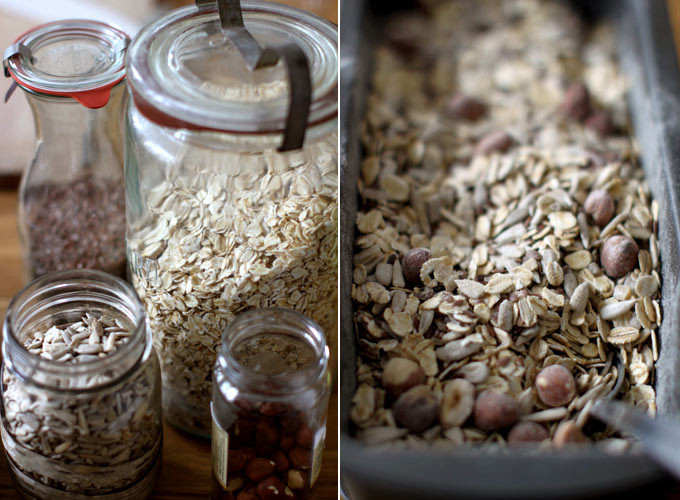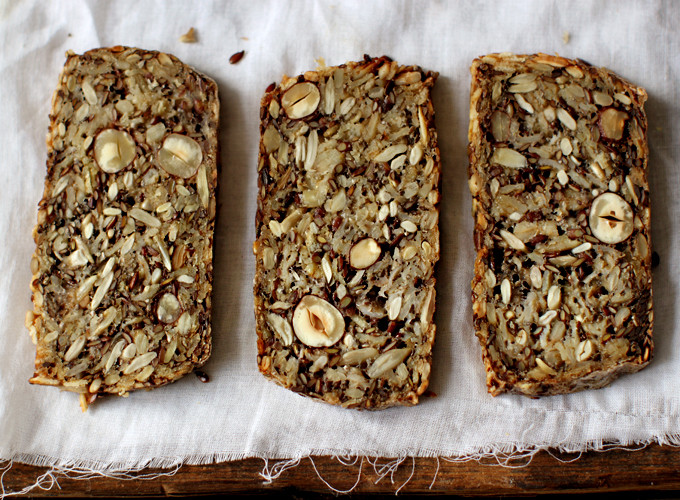It took me a while to decide on the title for this post. Why? Because suggesting that a simple loaf of bread can change your life is quite a statement. However, the Life-Changing Loaf of Bread truly lives up to its name. I’m confident enough to make such a bold claim.
Alt text: Close-up of a beautifully textured Life-Changing Loaf of Bread, showcasing its golden crust and visible seeds and nuts.
When I started eating healthier, bread was definitely on my list of foods to reconsider. Not because bread is inherently “bad” – I don’t believe in such strict categorizations – but I realized that basing three meals a day around crusty, white French bread wasn’t serving my health goals. I understood that by reducing my bread consumption, I could make room for more nutrient-rich foods like greens, fresh fruits, and legumes, ultimately getting more nutrients for the same calorie intake. It was a real eye-opener.
Now, this doesn’t mean my love affair with bread ended. Not at all. When I moved to Denmark four years ago, I fell in love with bread all over again. This time, however, it wasn’t the light and fluffy kind. It was more like the Danish weather – dark, deep, and intense. Danes are masters of bread making, especially when it comes to sourdoughs and rye bread. Their bread is hearty, filling, and a single slice can almost be a meal in itself. I adore visiting the bakery on Saturday mornings to get a loaf of rye bread that has naturally risen for days, baked for 24 hours, and feels as dense as a brick.
People often ask why I don’t bake my own bread, and the answer is simple: the Danes simply do it better. And I cherish the ritual of walking along the canal to the bakery – rye bread is one of the few ready-made items I regularly buy. This way, I appreciate bread on a different level, and it becomes something special. I savor every slice instead of making it an everyday staple.
My life truly changed a couple of weeks ago when I had lunch at a friend’s house. As soon as I walked into her apartment, I could smell it – something malty and baked, toasty, nutty… When I turned the corner into her kitchen, there it was: a stunning loaf of bread, picture-perfect, studded with sunflower seeds, chia seeds, and almonds, golden at the edges, practically begging to be sliced.
She served it with various spreads: pesto, lentil hummus, and some veggie pâté. It magically complemented everything I spread on its speckled surface. It was moist, dense, chewy, with hints of sea salt here and there, nestled between the oats, near a golden flax seed. It was beautiful and, more than just tasty, it was a revelation. “Please tell me this is good for me!” I pleaded. She just smiled.
Friendly Fiber: Psyllium Seed Husks
You’re probably wondering how this bread holds together without any flour. That’s a great question, and the answer is psyllium seed husks.
Psyllium seed husks are among nature’s most absorbent fibers, capable of absorbing over ten times their weight in water. Psyllium comes from the Plantago ovata plant, related to the common plantain. This is why you often find psyllium in over-the-counter laxatives, stool-bulking agents, and colon cleansing kits – essentially anything related to digestion. I recently returned from a detox course in Lisbon where I educated participants about this incredible supplement that also helps lower cholesterol, improve digestion and weight loss, and relieve diarrhea and constipation.
Psyllium seed husks contain both soluble and insoluble fiber. Soluble fiber dissolves in water, soothing the digestive tract with its mucilaginous properties, while insoluble fiber acts like a broom, sweeping toxins from the colon. During a detox, juice cleanse, or fast, psyllium can significantly enhance the body’s ability to eliminate impurities. But the good news is, you can take it anytime. Many find that a daily teaspoon or two in a glass of water helps regulate their bowel movements.*
But what does this have to do with bread? The idea is to use psyllium to bind all these wonderful ingredients together without using flour. Recently, some low-carb bread recipes have emerged online utilizing psyllium, and I think it’s a fantastic idea. Enjoy delicious bread and promote healthy digestion – I’m in!
Psyllium is available in health food stores and most pharmacies. It comes in two forms: raw husks and powder (pulverized husks). Powdered psyllium dissolves more easily in water, but for this bread, either form works perfectly.

Alt text: Slices of Life-Changing Loaf of Bread stacked on top of each other, showing the dense texture and visible seeds.
Now, let me explain the title, “Life-Changing.”
I know you’re eager for me to justify this bold claim, so here are a few compelling reasons:
Firstly, when I bake regular bread, there are bowls, spoons, measuring cups, and flour everywhere. There’s always a mess to clean up, and my biggest pet peeve is trying to scrape the last bit of dough from the mixing bowl. This bread, however, leaves you with only a used spoon and a measuring cup. Everything is mixed directly in the loaf pan. Genius!
Secondly, traditional bread almost always requires kneading, then waiting, and perhaps more kneading. Maybe more waiting? It can get confusing. This bread, on the other hand, is incredibly simple. Just dump all the ingredients into the loaf pan, stir, and let it sit for a couple of hours – or overnight, all day, or however long you find convenient. You control the bread, not the other way around.
Thirdly, bread recipes are often very specific. Use this type of flour, and that type of yeast… But what if I told you that if you don’t have hazelnuts, you can use almonds? If you dislike oats, you can use rolled spelt? Out of maple syrup? Use honey! You see where I’m going with this? The only crucial point is to substitute ingredients in similar proportions and with similar types. The rest is up to you.
Fourthly, breads typically need a rising agent, whether it’s a sourdough starter (which takes days to prepare) or commercial yeast (best avoided if possible). This bread doesn’t need any. Fantastic!
Fifth reason, typical packaged grocery store bread isn’t really that healthy. It uses flour, often stripped of much of its fiber, bran, and essential fats. Unless milled just hours before baking, it loses most of its nutrients through oxidation. It’s high in refined carbohydrates and often low in protein and healthy fats. Most breads require gluten-containing flours for texture and leavening, which many people are trying to reduce in their diets. And sometimes, bread even contains strange ingredients like corn syrup and food coloring. Seriously, read those labels.
The Life-Changing Loaf of Bread features whole grains, nuts, and seeds. It’s high in protein, incredibly high in fiber, gluten-free, and vegan. Everything is soaked for optimal nutrition and digestion. I’d even go as far as to say this bread is good for you.
Sixth, this bread makes the best toast. Ever.
4.80 from 44 votes
The Life-Changing Loaf of Bread
Ingredients
- 1 cup / 135g sunflower seeds
- ½ cup / 90g flax seeds
- ½ cup / 65g hazelnuts or almonds
- 1 ½ cups / 145g rolled oats
- 2 Tbsp. chia seeds
- 4 Tbsp. psyllium seed husks (3 Tbsp. if using psyllium husk powder)
- 1 tsp. fine grain sea salt (add ½ tsp. if using coarse salt)
- 1 Tbsp. maple syrup (for sugar-free diets, use a pinch of stevia)
- 3 Tbsp. melted coconut oil or ghee
- 1 ½ cups / 350ml water
Instructions
- In a flexible, silicon loaf pan, combine all dry ingredients, stirring well. Whisk maple syrup, oil, and water together in a measuring cup. Add this to the dry ingredients and mix thoroughly until everything is completely soaked and the dough becomes very thick. If the dough is too thick to stir, add one or two teaspoons of water until manageable. Smooth the top with the back of a spoon. Let sit on the counter for at least 2 hours, or all day or overnight. The dough is ready when it retains its shape even when you pull the sides of the loaf pan away from it.
- Preheat oven to 350°F / 175°C.
- Place loaf pan in the oven on the middle rack and bake for 20 minutes. Remove bread from the loaf pan, place it upside down directly on the rack, and bake for another 30-40 minutes. The bread is done when it sounds hollow when tapped. Let cool completely before slicing (difficult, but important).
- Store bread in a tightly sealed container for up to five days. Freezes well – slice before freezing for easy toast!
Notes
Makes 1 loaf
Sarah Britton Click here to print this recipe
I understand that few pleasures in life can compete with tearing open a fresh baguette or slicing into a thick-crusted country levain, and I’m not suggesting we forget those joys. On the contrary, let’s appreciate them for what they are and enjoy them occasionally. But for now, and hopefully for a significant portion of your bread-eating days, I offer you my latest and greatest pleasure: the Life-Changing Loaf of Bread – a bread with no downsides, full of personality, a triumphant declaration that deliciousness and health are not mutually exclusive.
This bread changed my life. Will it change yours too?
For visual learners and those who’d like to join me in my kitchen, the Life-Changing Loaf of Bread is featured in my wellness platform, My New Roots Grow, which offers live and recorded cooking classes. Check it out!
Q & A
I’m happy to answer common questions about substitutions for the Life-Changing Loaf of Bread that come up in the comments. Please note that I cannot guarantee results beyond the recipe provided above. If you do make a successful substitution, please share it in the comments! Thanks!
- There is no substitute for psyllium husks. When I write about a specific ingredient, it’s because THAT is central to the recipe, and I want to highlight one way to use it. If you can’t find psyllium, buy it online. It’s inexpensive.
- For nut substitutions, the bulk of this bread is nuts and seeds, so you’ll need to skip the recipe if you have severe nut allergies. If it’s just a nut allergy and seeds are okay, replace the nuts with seeds.
- You can use ground flax seeds instead of whole, but you’ll need significantly more water as ground flaxseed is highly absorbent.
- Substituting oats with quinoa flakes might work, but again, they absorb more water than oats. Adjust water accordingly.
- Oats are inherently gluten-free, but if you have gluten sensitivity, ensure you purchase certified gluten-free oats.
- For sugar-free or low-sugar diets, use a pinch of stevia to replace maple syrup.
- A flexible, silicon loaf pan is ideal because you can easily check if the dough is holding together and remove the loaf. However, a regular pan should also work.
- This bread is not raw. I haven’t tried dehydrating it. If you want to make it raw, consider slicing it before baking and dehydrating the slices individually.
* If you are considering taking a dietary psyllium supplement, please read the instructions carefully. Do not give psyllium to young children, as it can be a choking hazard.


